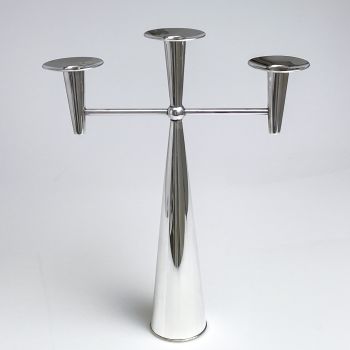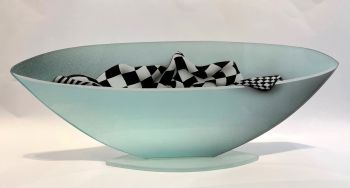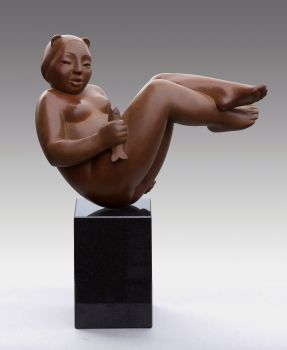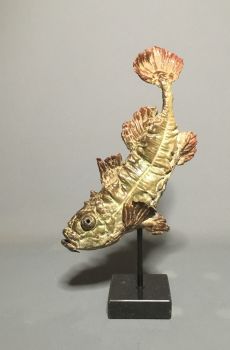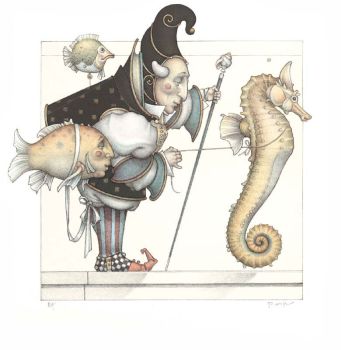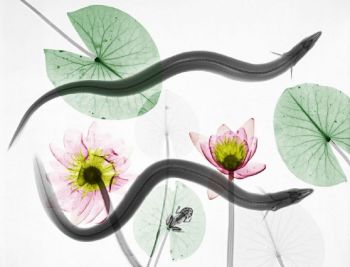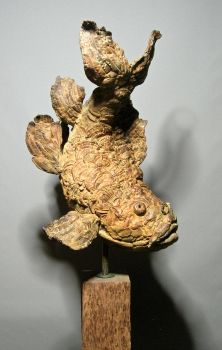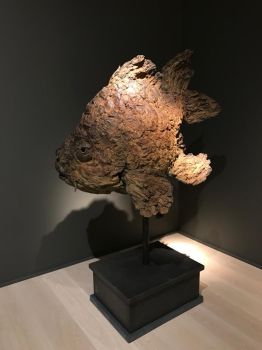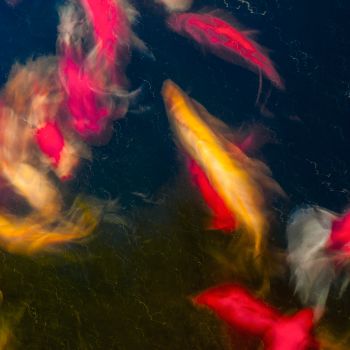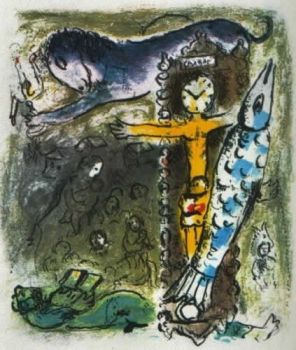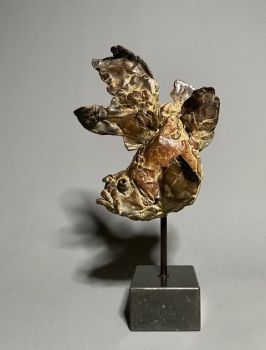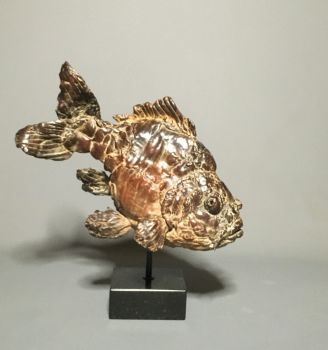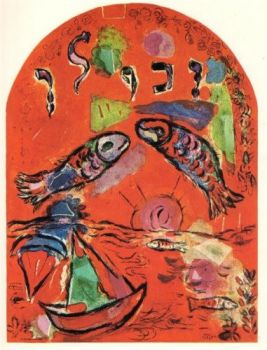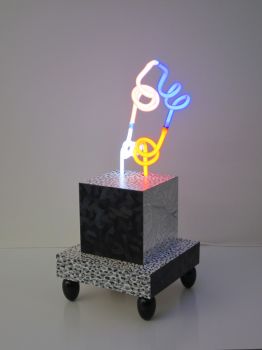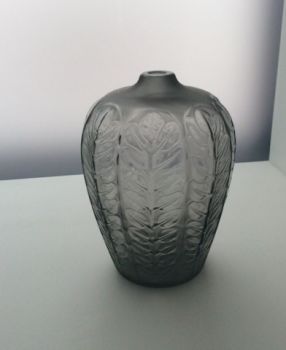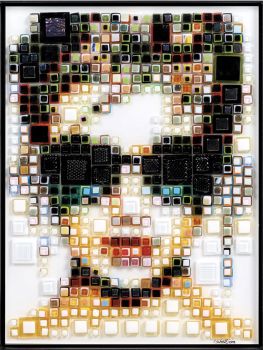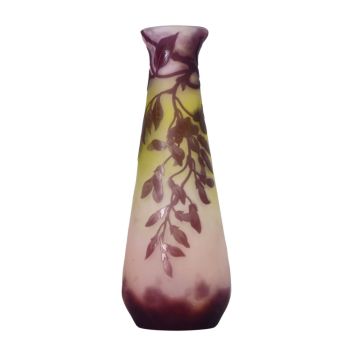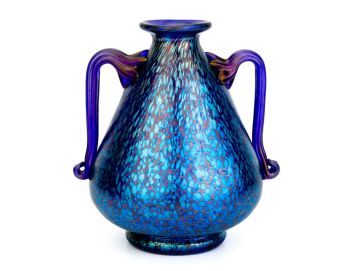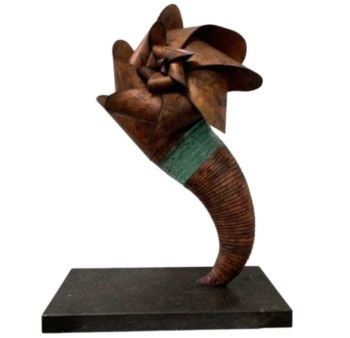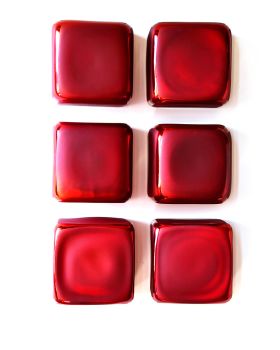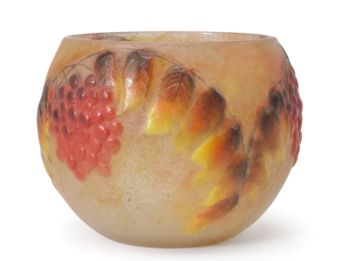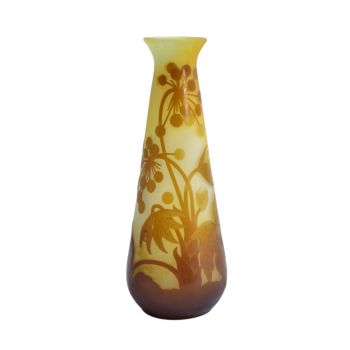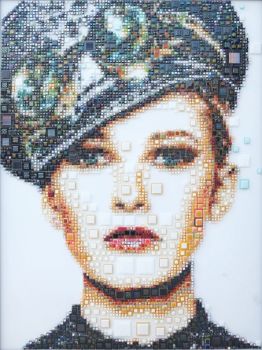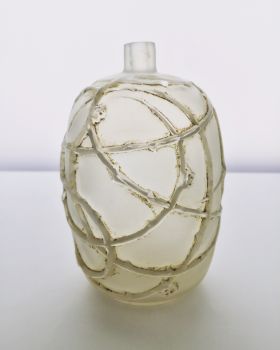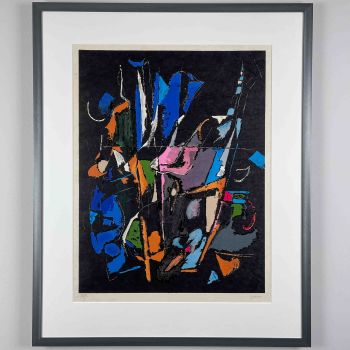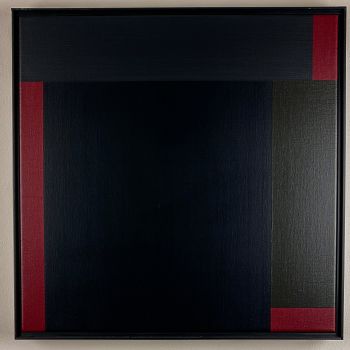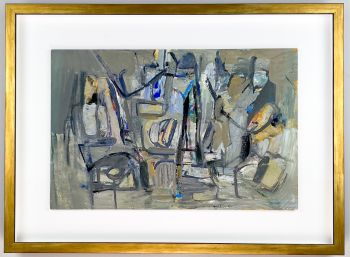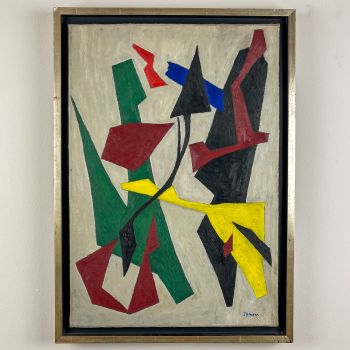A glass art-object “Ruutana” or "Crucian Carp", model KF 226 – Nuutajärvi-Notsjö Finland 1961
Kaj Franck
Verre
9 ⨯ 21 ⨯ 6 cm
ConditionVery good
€ 2.850
Van Kerkhoff Art
- Sur l'oeuvre d'artAn art-object in the shape of a fish (‘Ruutana’ or Crucian Carp), made of green lead glass with tin crush bubbles. Free-blown with ground and polished base, stylised flattened ovoid body with shaped tail.
This “Ruutana” is model KF 226 in the series of art-objects designed by Kaj Franck. It was produced between 1954 and 1962 by the Nuutajärvi-Notsjö glassworks, winning the Diplôme d’Honneur at the Milan Triennale in 1954. It is a stylised lifesize version of the Crucian Carp, a species widespread across Northern-Europe as far as the Arctic circle in Scandinavia.
The object is signed fully underneath the base: Kaj Franck – Nuutajärvi-Notsjö 61 (1961) and is in very good condition.
About Kaj Franck
Kaj Franck (Vyborg, Finland 1911 – Santorini, Greece 1989), a pioneering Finnish designer and a prominent figure in the Finnish art world from 1940 to 1980, left an indelible mark on the design landscape. Today, his name is synonymous with excellence and innovation, as exemplified by the prestigious “The Kaj Franck Design Prize,” which is annually awarded by the esteemed Finnish Design Forum.
Born in 1911 on the Finnish-Russian border into a family with a rich architectural heritage, Franck had design in his blood. His grandfather held a prominent position as the director of the renowned Arabia Ceramics factory, underscoring the influence and inspiration that surrounded him from an early age.
Franck pursued his passion for design by studying at the furniture department of Taideteollinen korkeakoulu, known today as the Aalto University School of Arts, Design, and Architecture, in Helsinki. Equipped with a solid foundation in design principles, he embarked on a career as a freelance designer before joining Arabia in 1945. It was during his time at Arabia that Franck’s talent truly flourished, and in 1950, he assumed the role of the company’s Artistic Director.
While his contributions to Arabia were significant, Franck’s creative vision extended beyond ceramics. He also designed glass objects for Iittala between 1946 and 1950, and later for Nuutajärvi-Notsjö glassworks from 1950 to 1976. His designs, particularly in everyday tableware and glassware, propelled him to the forefront of the design world. Notably, his iconic Kilta tableware and Kartio glassware are celebrated as revolutionary and enduring symbols of classic Finnish design.
Franck’s design philosophy embodied a profound commitment to principles of moderation, ecology, and equality. Often referred to as “the conscience of Finnish design,” he advocated for minimalism and the conscious reduction of everyday objects, emphasizing the importance of sustainability and product life cycles. Franck’s designs were a testament to his belief that beauty and functionality could coexist harmoniously, enhancing the lives of individuals while respecting the environment.
Recognized for his exceptional contributions, Franck’s works grace the collections of esteemed museums worldwide. Noteworthy institutions such as the Design Museum Helsinki, the Museum of Modern Art in New York, the Stedelijk Museum Amsterdam, and The British Museum in London all proudly display his creations. Throughout his illustrious career, Franck received numerous accolades, including the prestigious Lunning Prize in 1955, as well as “Grand Prix” and multiple “Gold Medals” at the renowned Triennale di Milano.
Kaj Franck’s enduring legacy rests not only on his remarkable designs but also on his unwavering commitment to advancing the field of design. His vision, which emphasized sustainability, simplicity, and social consciousness, continues to inspire designers and enthusiasts alike, ensuring that his influence will be felt for generations to come.
Marked
Signed underneath the base: K. Franck Nuutajärvi-Notsjö '61 (1961)
Execution
Nuutajärvi-Notsjö glassworks, Finland 1961
Condition
This Ruutana is in good condition. Some light scratches and wear consistent with age and use. No chips or cracks.
Literature
Marianne Aav (ed.), Kaj Franck, Universal Forms, p.323
Dimensions
Height 9,8 cm
Width 21 cm
Depth 6,2 cm - Sur l'artiste
Le designer finlandais de céramique et de verre Kaj Franck (1911-1989) a réalisé une vérité puissante au cours de sa brillante carrière : simple est beau. Bien que le monde évolue à un rythme toujours plus rapide, d'une décennie à l'autre, cette simple vérité demeure. L'inspiration et les principes de Franck ont lancé une tradition dans le design finlandais, qui est toujours vivante et forte aujourd'hui. Ses œuvres les plus connues sont les séries Iittala Teema et Kartio, et son héritage fait partie de chaque foyer finlandais.
"Je veux utiliser des objets qui sont tellement évidents qu'ils ne sont pas perceptibles", Kaj Franck a défini son propre travail. Ses créations répondaient aux besoins humains fondamentaux tout en leur servant des outils avec des propriétés d'objets du quotidien. Franck s'intéressait également aux basses- coûter la production de masse et fuir le matérialisme, la culture du jetable et la frime. L'univers de Franck se composait de formes mathématiques basiques et de formes simples, décorées uniquement de couleurs fortes.
Le point de départ du travail de Franck était l'aspect pratique allié à la beauté. Bien que cela semble aller de soi aujourd'hui, à son époque sa pensée était radicale. Franck a séparé les styles et les tendances de la mode de la tradition et lui a donné un tout nouveau sens. Dans la période 1952-53, Franck a montré que la vaisselle n'avait pas besoin d'être trop complexe avec la sortie de la série Kilta comme déclaration forte - c'était une idée nouvelle que chacun pouvait faire des réglages de table selon ses propres besoins. .
Franck a commencé ses créations en se concentrant sur l'idée ou le concept sous-jacent, pas sur la forme. Cet accent mis sur l'aspect idée du design a également été appliqué à son travail d'enseignant et plus tard de directeur artistique à l'Université d'art et de design d'Helsinki. Franck a également été l'un des premiers défenseurs du recyclage, et il a souvent été appelé la "conscience du design finlandais". Franck a remporté de nombreux prix au cours de sa brillante carrière et est devenu internationalement célèbre. Aujourd'hui, le prix Kaj Franck est la plus prestigieuse distinction de design finlandaise. .
Êtes-vous intéressé par l'achat de cette oeuvre?
Artwork details
Related artworks
- 1 - 4 / 10
- 1 - 4 / 24
Gabriel Argy-Rousseau
Gabriël Argy-Rousseau – Crabes et Algues vase – 19201920 - 1929
Prix sur demandeAntiques Emporium
1 - 4 / 24- 1 - 4 / 24
Frères Daum
Daum Nancy – “Paysage Soleil Couchant” vase with two applied handles1900 - 1910
Prix sur demandeAntiques Emporium
Artiste Inconnu
François-Théodore Legras – Tall “Fleurs de Pommier” apple blossoms vase1900 - 1909
Prix sur demandeAntiques Emporium
Johann Loetz (Lötz) Witwe Klostermühle
Johann Loetz Witwe – Jugendstil Cobalt Papillon vaas1900 - 1910
Prix sur demandeAntiques Emporium
1 - 4 / 24- 1 - 4 / 12

















